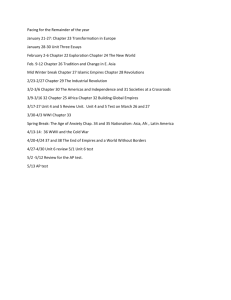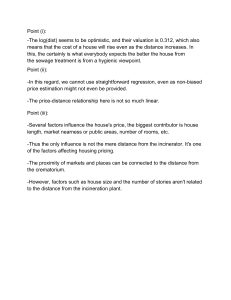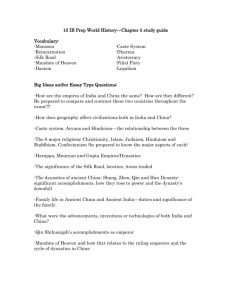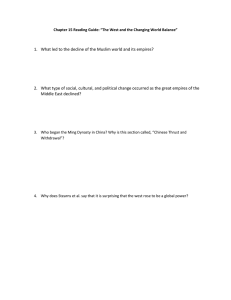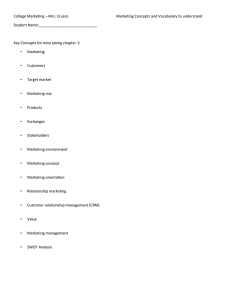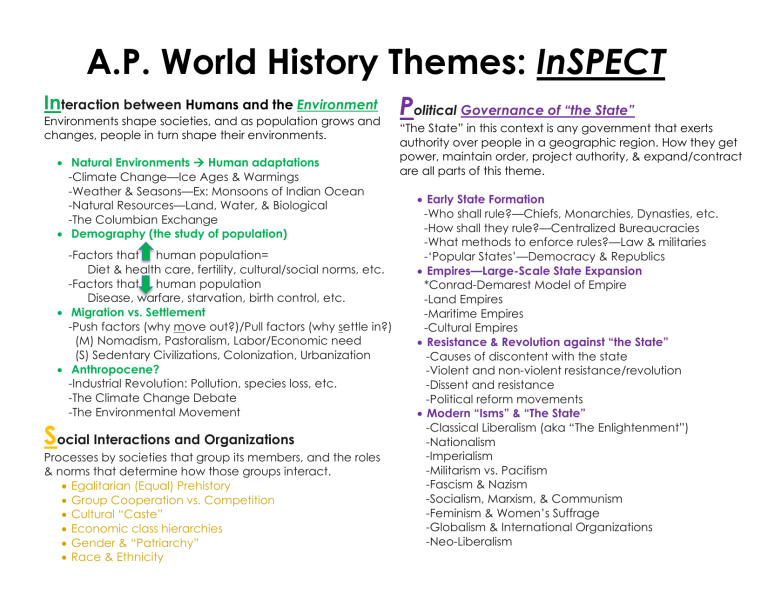
A.P. World History Themes: InSPECT Interaction between Humans and the Environment Environments shape societies, and as population grows and changes, people in turn shape their environments. • Natural Environments à Human adaptations -Climate Change—Ice Ages & Warmings -Weather & Seasons—Ex: Monsoons of Indian Ocean -Natural Resources—Land, Water, & Biological -The Columbian Exchange • Demography (the study of population) -Factors that human population= Diet & health care, fertility, cultural/social norms, etc. -Factors that human population Disease, warfare, starvation, birth control, etc. • Migration vs. Settlement -Push factors (why move out?)/Pull factors (why settle in?) (M) Nomadism, Pastoralism, Labor/Economic need (S) Sedentary Civilizations, Colonization, Urbanization • Anthropocene? -Industrial Revolution: Pollution, species loss, etc. -The Climate Change Debate -The Environmental Movement Social Interactions and Organizations Processes by societies that group its members, and the roles & norms that determine how those groups interact. • Egalitarian (Equal) Prehistory • Group Cooperation vs. Competition • Cultural “Caste” • Economic class hierarchies • Gender & “Patriarchy” • Race & Ethnicity Political Governance of “the State” “The State” in this context is any government that exerts authority over people in a geographic region. How they get power, maintain order, project authority, & expand/contract are all parts of this theme. • Early State Formation -Who shall rule?—Chiefs, Monarchies, Dynasties, etc. -How shall they rule?—Centralized Bureaucracies -What methods to enforce rules?—Law & militaries -‘Popular States’—Democracy & Republics • Empires—Large-Scale State Expansion *Conrad-Demarest Model of Empire -Land Empires -Maritime Empires -Cultural Empires • Resistance & Revolution against “the State” -Causes of discontent with the state -Violent and non-violent resistance/revolution -Dissent and resistance -Political reform movements • Modern “Isms” & “The State” -Classical Liberalism (aka “The Enlightenment”) -Nationalism -Imperialism -Militarism vs. Pacifism -Fascism & Nazism -Socialism, Marxism, & Communism -Feminism & Women’s Suffrage -Globalism & International Organizations -Neo-Liberalism Economic Systems How a society develops, produces, exchanges/trades, and consumes goods and services. • Agriculture & Metals-The Early Bases of Economies -“Cereal” grains=seeds you eat (wheat, corn, rice) -Cash crops=valuable plants (sugar, cotton, tobacco) -Metals: Tin+Copper=Bronze, Iron/Steel, Gold, & Silver • Goods & Services -Luxury goods-A “want” conveying status through display and/or consumption: Examples include jewelry, textiles like silk, spices, ivory, porcelain, etc. -Services-A non-manufacturing business that does work for consumers: Examples include trading houses, banking, health care, etc. • Production & Labor -Familial/household productionà “cottage industry” -Specialization of Laborà “artisanal labor” -AgriculturalàManorialism, Encomienda, Plantations -Industrializationà Factory systems -Labor systems are relatively “free”(f) or “coerced”(c) depending on how much choice the worker has: (f) an artisan, peasant, wage laborer, migrant worker (c) a slave, serf, indentured servants, mit’a, corvee, • Major Historical Trade Routes (terms to know) -The Mediterranean Sea (Greco-Roman colonies) -The Americas (Aztec ‘pochteca’) -Silk Routes (caravans & caravanserai) -Trans-Sahara (caravans & oasis) -Indian Ocean (trading post/port) -Atlantic (triangular trade & the middle passage) • Other important Economic Terms -Exchange Types: barter, money, credit, commodities -Organizations: guilds, banks, companies & corporations -Politics in the economy?: tribute, farm taxes, tariffs, mercantilism, laissez-faire, capitalism, communism, etc. Cultural Developments & Interactions The stories/myths, religions, philosophies & ideas, arts, architecture, sports, entertainment, etc. that explain how groups view themselves & interact with others. • Early Creation Stories & Mythologies -Animism, Shamanism, Naturalism, etc. -Early writing & “Epics” • Religions -Polytheistic (many gods): Ex. Hinduism, Aztec gods, etc. -Monotheistic (1 God): Ex. Judaism, Christianity, & Islam -Is it a Religion or a Philosophy?: Buddhism • Philosophies & Ideas -East Asian: Ex. Filial Piety, Confucianism, Daoism -European: Ex. Greek Rationalism, Roman Philosophy, Humanism, Enlightenment, Social Darwinism, etc. • Arts, Architecture, Language, Sports, & Entertainment • Cultural Processes -Cultural Diffusion=The “spread” of a culture -Cultural Syncretism=The “blending” of 2 or more cultures -Diaspora=A spreading of a group of people, voluntarily or involuntarily, who bring their culture into a new area to create a “Diasporic Community” Technology and Innovation Human advances in each theme strive to progressively increase comfort, safety, efficiency, etc., but these advances have intended & unintended consequences. • Interaction-Ex: stone tools, metallurgy, saddles, energy, astronomy, sailing, steam engines, genetics, etc. • Social-Ex: textile production=fashion & elite status, telephones & social media=community connection • Political-Ex: military tech. like gunpowder, empires sponsoring scientists, walls, urban-planning • Economics-paper money, credit & banking, stock markets, the ‘gig’ economy (eg. Uber, AirBnB)
